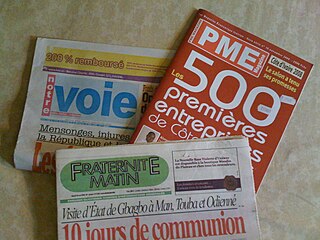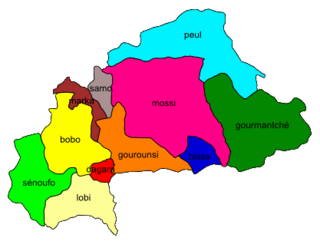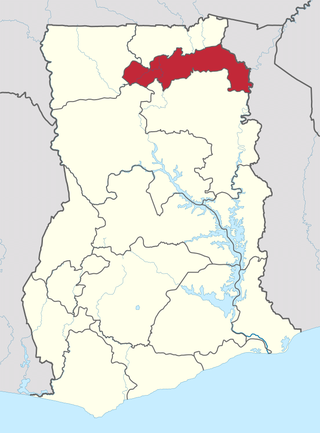Related Research Articles

Hausa is a Chadic language that is spoken by the Hausa people in the northern parts of Nigeria, Ghana, Cameroon, Benin and Togo, and the southern parts of Niger, and Chad, with significant minorities in Ivory Coast. A small number of speakers also exist in Sudan.

The Volta River is the main river system in the West African country of Ghana. It flows south into Ghana from the Bobo-Dioulasso highlands of Burkina Faso. The main parts of the river are the Black Volta, the White Volta, and the Red Volta. In the northwest, the Black Volta forms the international borders between the Ivory Coast, Ghana, and Burkina Faso. The Volta flows southward along the Akwapim-Togoland highlands, and empties into the Atlantic Ocean at the Gulf of Guinea at Ada Foah. One of its smaller tributaries, the Oti River, enters Ghana from Togo in the east. The Volta River has been dammed at Akosombo for generating hydroelectricity. The reservoir named Lake Volta stretches from Akosombo Dam in the south to the northern part of the country, and is the largest man-made reservoir by area in the world.

The Bambara are a Mandé ethnic group native to much of West Africa, primarily southern Mali, Ghana, Guinea, Burkina Faso and Senegal. They have been associated with the historic Bambara Empire. Today, they make up the largest Mandé ethnic group in Mali, with 80% of the population speaking the Bambara language, regardless of ethnicity.

Ghana is a country of 33.48 million people and many native groups, such as:
The Dyula are a Mande ethnic group inhabiting several West African countries, including Mali, Cote d'Ivoire, Ghana, and Burkina Faso.
The Ligbi people speak a Mande language in Ghana, in the north-west corner of the Brong-Ahafo Region. Ligbi is spoken by approximately 10,000 speakers. It is fairly closely related to Jula, Vai and Kono. A small population of Ligbi speakers is reported to live in Ivory Coast. Ligbi is also known as Wela (Hwela) or Numu. The latter of these refers to a subsection of the Ligbi people; Numu is Dyula for 'blacksmith'.
The Akan people are a Kwa group living primarily in present-day Ghana and in parts of Ivory Coast and Togo in West Africa. The Akan speak dialects within the Central Tano branch of the Potou–Tano subfamily of the Niger–Congo family. Subgroups of the Akan people include: the Agona, Akuapem, Akwamu, Akyem, Anyi, Ashanti, Baoulé, Bono, Chakosi, Fante, Kwahu, Sefwi, Wassa, Ahanta, and Nzema, among others. The Akan subgroups all have cultural attributes in common; most notably the tracing of matrilineal descent in the inheritance of property, and for succession to high political office.

The Ewe people are a Gbe-speaking ethnic group. The largest population of Ewe people is in Ghana, and the second largest population is in Togo. They speak the Ewe language which belongs to the Gbe family of languages. They are related to other speakers of Gbe languages such as the Fon, Gen, Phla /Phera, Ogun/Gun, Maxi, and the Aja people of Togo and Benin.
The diverse culture of Ivory Coast, a coastal West African country bordered by Ghana, Liberia, Mali, Burkina Faso, and Guinea, is exemplified by a multitude of ethnic groups, events, festivals, music, and art.
Gonja are an ethnic group that live in Ghana. The Gonja established a kingdom in northern Ghana of the same name, which was founded in 1675 by Sumaila Ndewura Jakpa.
The Wangara are a diaspora community of ethnic Soninke origin who served as specialized long-distance merchants throughout West Africa, particularly in Trans-Saharan trade. Originating from the Ghana Empire, over time the Wangara became integrated into numerous other communities and ethnic groups, particularly in Timbuktu, Agadez, Kano, Gao, Salaga, Kong, Bissa, Kankan, Fouta Jallon, Djenné as well as Bambouk, Bure, Lobi, and Bono goldfields and Borgu. They were practicing Muslims who helped spread the religion widely and served as clerics, political advisors, healers and marabouts, often following the Suwarian Tradition.

East Mamprusi Municipal Assembly is one of the six districts in North East Region, Ghana. Originally created as an ordinary district assembly in 1988 when it was known as East Mamprusi District, which was created from the former Mamprusi District Council, until the eastern part of the district was split off by a decree of president John Agyekum Kufuor on 19 August 2004 to create Bunkpurugu-Yunyoo District; thus the remaining part has been retained as East Mamprusi District. However on 15 March 2018, it was elevated to municipal district assembly status to become East Mamprusi Municipal District. The municipality is located in the eastern part of North East Region and has Gambaga as its capital town.

Ghana is a multilingual country in which about eighty languages are spoken. Of these, English, which was inherited from the colonial era, is the official language and lingua franca. Of the languages indigenous to Ghana, Akan is the most widely spoken in the south. Dagbani is most widely spoken in the north.

Ivory Coast is a multilingual country with an estimated 69 languages currently spoken. The official language, French, was introduced during the colonial period. This language is taught in schools and serves as a lingua franca in the country, along with Dioula.
Bissa is a Mande ethnic group of south-central Burkina Faso, northeastern Ghana and the northernmost tip of Togo. Their language, Bissa, is a Mande language that is related to, but not the same as, a cluster of languages in the old Borgu Kingdom area of Northeast Benin and Northwest Nigeria, including Busa, Boko, and Kyenga. An alternate name for the Bissa is Busansi or Busanga which is used by the Mossi people.

Bissa, is a Mande ethnic group of south-central Burkina Faso, northeastern Ghana and the northernmost tip of Togo. Their language, Bissa, is a Mande language that is related to, but not the same as, a cluster of languages in the old Borgu Kingdom area of Northeast Benin and Northwest Nigeria, including Busa, Boko, and Kyenga. An alternate name for the Bissa is Busansi which is used by the Mossi people and Kusasi people or Busanga.
Mamprusis are an ethnic group in northern Ghana and Togo. Estimates are that there are about 200,000 Mamprusis living in the Northern Regions of Ghana as of 2013. They speak Mampruli, one of the Gur languages. In Ghana, the Mamprusis live mainly in Nalerigu, Gambaga, Walewale, and their surrounding towns and villages in the North East Region. Their origin is in the Upper East Region, principally, Bawku, and they also inhabit parts of the Upper West Region, too.
The Mampruli language is a Gur language spoken in northern Ghana, Northern Togo, Burkina Faso, Ivory Coast and Mali by the Mamprusi people. It is partially mutually intelligible with Dagbani. The Mamprusi language is spoken in a broad belt across the northern parts of the Northern Region of Ghana, stretching west to east from Yizeesi to Nakpanduri and centred on the towns of Gambaga, Nalerigu and Walewale.

The North East Region is one of the sixteen regions of Ghana. It is located in the north of the country and was created in December 2018 after a referendum was voted upon to break it off of the Northern region. The region's capital is Nalerigu.
Karimenga is a village and a farming community in the West Mamprusi Municipality in the Bunkpurugu/Nakpanduri District in the North East Region of Ghana. On its hills, is the location of a two-bedroom apartment which was the hideout of Dr. Kwame Nkrumah which was once known as “Kwame Nkrumah Guest House”.
References
- ↑ Olson, James Stuart (1996). The peoples of Africa: an ethnohistorical dictionary. Santa Barbara, CA: Greenwood Press. p. 18. ISBN 978-0-313-27918-8 . Retrieved 18 April 2010.
- ↑ School, Live Lingua-Online Language. "Learn Anufo Free: Online Anufo Courses". Live Lingua. Retrieved 24 June 2023.
- ↑ B, Erin. "Anufo Language". ghanavisions.com. Archived from the original on 14 November 2016. Retrieved 14 November 2016.
- ↑ Kirby 1986, p. 34